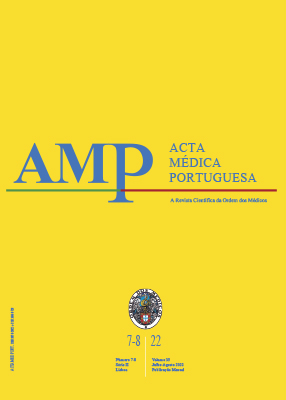Readmissions to a Pediatric Ward: An Eleven-Year Experience in a Portuguese Hospital
DOI:
https://doi.org/10.20344/amp.17011Keywords:
Child, Hospitals, Pediatric, Patient Discharge, Patient ReadmissionAbstract
Introduction: Pediatric readmissions have received increased attention in the past few years. Distinguishing between planned and unplanned readmissions and between preventable and unpreventable ones constitutes an important target to better understand this thematic. The aim of this study was to analyze the readmission rate and characterize the population readmitted within a 30-day period after discharge in the pediatric ward of a level II hospital.
Material and Methods: Observational retrospective single center study of the pediatric patients who were discharged from a level II hospital, between 2009 and 2019, and had at least one readmission within 30 days after discharge. Clinical and demographic data were obtained from the analysis of the patient’s medical records. We considered as potentially preventable all the unplanned readmissions that were related with the index admission.
Results: From the 6879 admissions during the study period, 4.8% resulted in readmissions within the next 30 days. Excluding the planned readmissions, the seven, 15 and 30-day readmission rates were respectively 1.7%, 2.7% and 3.9%. Most of the unplanned readmissions (77%) were considered as potentially preventable. Patients reevaluated in the Pediatric Day Hospital after discharge had shorter intervals to readmission. Readmissions due to decompensation of chronic disease were more likely related with the index admission. Patients with chronic disease, as well as patients with neurological impairment were more likely to have multiple readmissions.
Conclusion: We found a low overall readmission rate, but a higher percentage of potentially preventable readmissions, when compared with the available literature.
Downloads
Downloads
Published
How to Cite
Issue
Section
License
All the articles published in the AMP are open access and comply with the requirements of funding agencies or academic institutions. The AMP is governed by the terms of the Creative Commons ‘Attribution – Non-Commercial Use - (CC-BY-NC)’ license, regarding the use by third parties.
It is the author’s responsibility to obtain approval for the reproduction of figures, tables, etc. from other publications.
Upon acceptance of an article for publication, the authors will be asked to complete the ICMJE “Copyright Liability and Copyright Sharing Statement “(http://www.actamedicaportuguesa.com/info/AMP-NormasPublicacao.pdf) and the “Declaration of Potential Conflicts of Interest” (http:// www.icmje.org/conflicts-of-interest). An e-mail will be sent to the corresponding author to acknowledge receipt of the manuscript.
After publication, the authors are authorised to make their articles available in repositories of their institutions of origin, as long as they always mention where they were published and according to the Creative Commons license.









